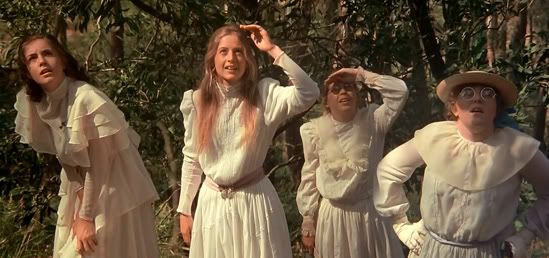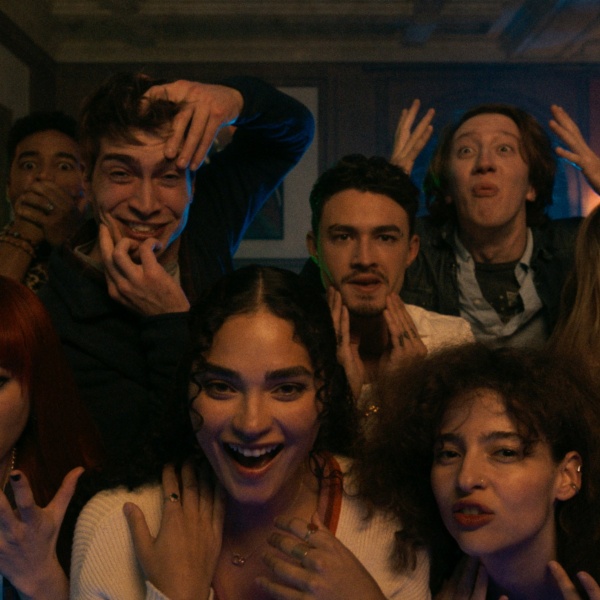…About The Filmmaker’s Career: Venerable Australian Director Discusses His Oeuvre At The Film Society of Lincoln Center

When Australian filmmaker Peter Weir talks, we listen, and so should you. The veteran director, responsible for the unimpeachable arty ’70s classics, “Picnic At Hanging Rock” and “The Last Wave“; the across-the-board successful “The Truman Show,” “Witness,” and “Dead Poets Society“; and the arty-intelligent epics “Master And Commander” and fresh-faced “The Way Back” — his latest, prison escape drama starring Jim Sturgess, Ed Harris, Colin Farrell and Saoirse Ronan — was revered in a retrospective at the Film Society of Lincoln Center that ran this past weekend in New York.
About Siberian prison camp escapees who risked their lives to walk 4000 miles overland to freedom in India, “The Way Back” — a meditative picture that’s almost trance-like at times — has already hit theaters in L.A. in limited release and it begins to expand on January 21. On the occasion of his latest — his first picture in eight years since “Master And Commander” — Weir made the rare appearance in New York to discuss the film and his body of work.
Weir is not only quality over quantity these days, he’s also extremely dedicated to his projects: with his newest, the director even employed a walking consultant, who journeyed the entire distance to get a proper feel for the drama and then thoroughly picked his brain. Anybody who does that has some serious stories to tell, and Weir didn’t disappoint. While a great two hour chat, here are some highlights and things we gleaned along the way.
1. A ship to Peru was the location for his first dabbling in TV/Film. It not only gave him the thirst for more, the trip turned into a life-changing expedition that set him on a quest for more experiences around the globe.
Quite bizarre, but a very young Weir and few others discovered a camera in a small cabin, one that connected to every dining hall and bar on the ship. Weir’s idea? Put on a show. “We put on six shows… to a captive audience… (laughs) something like ‘The Tonight Show,’ but eventually we got banned because we did a piece on the state of life boats which wasn’t that good. But I got off the ship and it was sort of a rite of passage. I wanted to do something like that, writing, acting, I didn’t think of directing.”
2. He wrote for an absurdist sketch comedy show and did his own personal films but focused on the latter after seeing “Monty Python.”
“We were very much in the vein of Monty Python, and I saw them in England and they were so superior to what we did… that was it. I told my writing partner I wanted to focus on films, I sold him my sketches and that was it. It was very difficult because he had just gotten a TV deal, and I think it was a show on ABC.”
3. Weir worked with comedians like Robin Williams and Jim Carrey in serious dramas because they risked failure.
Comedians can coast along — just look at Kevin James — but occasionally the pull from something deep and dark, creating an outstanding dramatic performance that never fails to surprise. It’s a gamble on their career, something that was very enticing to the filmmaker. “They’ve seen something in what I do that was edgy, in a Hollywood sense, and were looking for change. One of the great curses in creative work is when you become successful, you can get conservative. You need failure desperately to keep you in check. Failure is vital. These men risked it, and this energy between us was vital.”
4. The failure of “Mosquito Coast” threw him into depression, and into perhaps his career’s oddest film — “Green Card.”
While his highly successful “Dead Poets Society” came three years after “Mosquito Coast,” he began writing the romantic comedy “Green Card” almost immediately after — a picture that is by all means not brilliant or awful, but rather much more safe than he was ever known for. “I was down and out, I looked for something to do. I tried to find myself back into the market place. ‘Green Card’ was my reaction to that, I tried to get back in the game. If anything, that light comedy made me realize I only wanted to make difficult films.”
5. He will never direct a super hero movie.
Nearly every director — auteur or hack — has aspirations to direct a big super hero tentpole. Some do it to stay in the game, some don’t know any better, and others (or just Christopher Nolan) do it wisely, and to bankroll other projects. Weir, despite his acknowledgment of this new era, won’t have any of it. “In recent years the changes in Hollywood where my kind of filmmaking has been marginalized, it’s pushing me back to the independent world. The law of the jungle has changed, and you either adapt or get out. And I don’t want to get out, but I will not adapt to the degree that I’m going to do things that I don’t want to do. Taking on the children’s films that the studios are making… or the childish films, rather… (laughs).”
6. “Remains of the Day” was a project Weir almost directed.
Author Kazuo Ishiguro’s tale of an aged butler who begins to regret his dutiful loyalty was turned into a successful movie starring Anthony Hopkins in the early 90s, but that same script was in the hands of Mr. Weir first. He very much enjoyed the writing, but felt it would’ve been too unchallenging at that point in his life. “I read both ‘Remains of the Day’ and ‘Fearless‘ out loud to my wife, and while I loved ‘Remains of the Day,’ I thought… ‘Fearless,’ this is tougher, this is harder, and I wanted to go that route.”
7. Volcanic eruptions were part of the soundtrack of “Picnic at Hanging Rock.”
Few mystery movies are as entrancing as Weir’s eerie ‘Picnic,’ a moody picture whose secret is never solved. This was always the intention — the filmmaker often felt like the traditional “whodunit” film always suffered in its reveal — but he also realized that the lack of clarity may also be a let down. Therefore, he decided to craft the most atmospheric picture possible, searching for bizarre methods to cause audience discomfort. “I went to great lengths with the soundtracks, I put a slowed down volcanic eruption that were barely audible, even if on a good sound system you would feel some uneasiness, and I felt that way you would find it a satisfying experience.”
8. Stanley Kubrick recommended him for Stephen King’s “Salem’s Lot.”
Hollywood came knocking after ‘Picnic,’ and boy did they knock hard. “A producer came to me and said Stanley Kubrick suggested you for the job, they said, and he was like a mentor. I was working with (Romanian-American writer, director and producer) Petru Popescu and we were holed up for a month working on this, it was such an uncomfortable month, delving into that material was so unpleasant so I pulled out of it. I also don’t think I was ready for that harsh system, and I said ‘no,’ much to the astonishment to the people I was meeting.”
9. Unlike fellow Aussie directors, Weir never left residency at his home country.
This certainly goes for filmmakers that are anywhere that’s not L.A., but most make their way to live in the area of California at some point in their life. Despite doing films exclusively in the states, Peter didn’t, wanting to keep distance between himself and the states for his work. “I need the country to be foreign to me. I didn’t want it to become too familiar, I probably wouldn’t have gone into, for example, the Amish community, something most Americans haven’t delved into, for ‘Witness’.”
10. For Linda Hunt’s Oscar winning role as a male in “The Year of Living Dangerously,” she had to be credited differently and not reveal that she was actually a woman.
These contractual obligations might sound silly, but would anyone have taken her part seriously if they had known? Hard to say now, especially with this sort of thing happening more often (“I’m Not There,” “The Crying Game,” etc.), but the film’s producers saw no other way: she was the best for the role, a part that saw one fired and thousands tested. “All kinds of people tested after that… Wally Shawn, for example. Then someone showed me a resume of Linda Hunt, and I said great, let’s get him in here. Then they said it was a woman. (laughs) But she still showed up the next day and was fantastic. I told the producers, I’m going to show you three tests, one Hawaiian, one New York, and something else for the third… Hunt was in New York. I said What do you think? And they said the Hunt guy, right? So I said… there’s one small thing… (laughs) So she signed a contract that she could not reveal that she was a woman, and was credited as L. Fitz Hunt.”
11. In Weir’s opinion, “The Last Wave” has a lackluster story in comparison to what it could’ve been.
Probably just as ambitious and weird as ‘Picnic,’ “The Last Wave” is terrifyingly uncomfortable, following a lawyer in a case involving Aborigines and a taboo murder. Featuring brilliant sound design and a bottled spiritual aura, the director thought he could’ve done better. “It was like tuning in on a short wave radio, he had a very obscure, distant channel… I’d say things about their tribal life, then I’d try to cram it into the film, anything he told me. But it became more interesting what he was telling me than what I was shooting. It had a form and a story and so on, but I never felt I had gone as far as I’d like to have gone.”
12. Weir believes good direction is “finding the essence of things,” directors should study silent films.
It’s like pulling teeth to get some people to watch films with subtitles, but it’s serious dental work to get most to watch silent films in this day and age. Not that it’s not understandable — by today’s standards they can feel underdeveloped, hokey, etc. Weir explains that there’s still much to pull from them, and he uses Jean Renoir to back him up. “They’re very different from sound films. Renoir wrote a piece and said it was a different art film, I have to take his word for it because I wasn’t alive during their day, but he said something hypnotic happened with particularly the close up. Now we look back and the plots are rather sometimes fantastical, the power is still in them, some hypnotic effect from screen to audience. I think that’s where my interest lies now, the great discovery of film is close up, not sound not color, not widescreen, it is that we do see that other part of the close up. When you hire an actor you’re also hiring the image, the “other.” Like Ed Harris, very familiar but his eyes, can you see something in his eyes? Are they windows into his soul? I’d like to think the idea of good direction is finding the essence of things.”
“The Way Back” hits theaters in a, somewhat larger limited release, on January 21.



